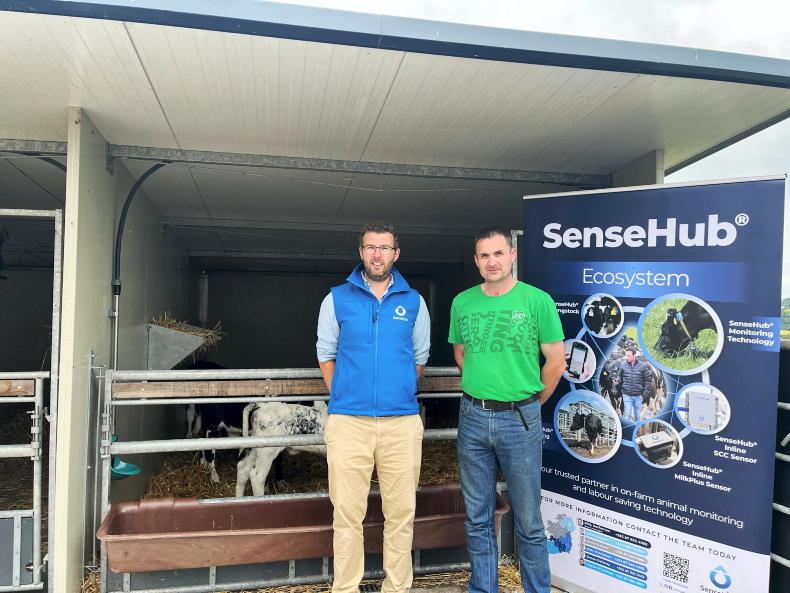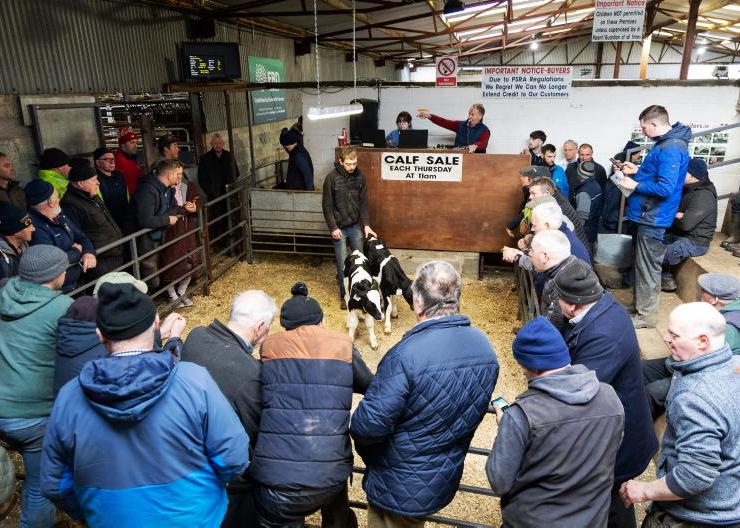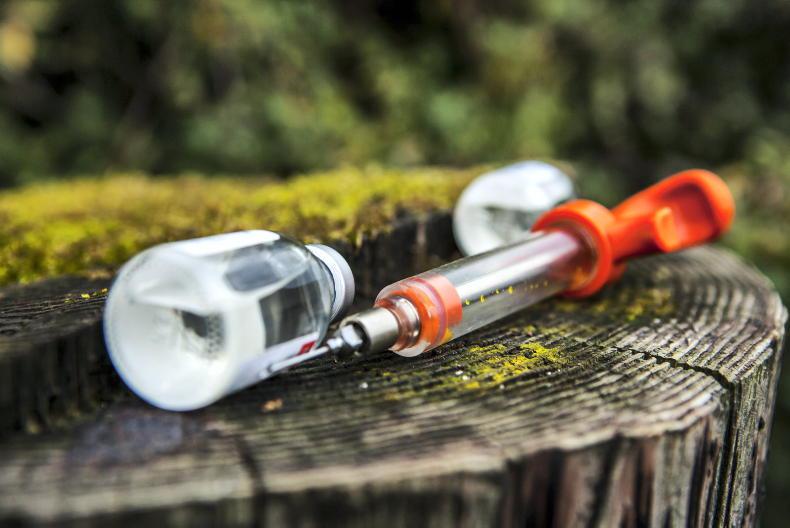1 How do you know if there isn’t enough straw in the calf pen?
The floor underneath the calf should not be visible. Straw is a great insulator and is good at keeping calves warm. Calves should be able to nestle into a bed of straw so their legs and belly are not visible. As well as having enough straw, the bed should also be clean and dry.
A simple test to determine if the calves are lying on a damp bed or not is the ‘knee test’ – if you kneel into the straw and your knee comes up damp (might be easier to see with waterproof trousers) the calves are lying on a damp/wet surface, which is not ideal.
2 How do you know if the calf pen/shed is too cold or draughty?
Get down to calf level in each pen and test when not wearing your winter proof clothing (i.e coat/jacket/hat). Any consistent air (less than five seconds) felt is considered a potential issue. Calves don’t like lying in a draughty spot, so watch where calves lie in the pen – they should be dispersed relatively evenly throughout.
If they are bunching in certain areas, check for cracks/crevices that might be letting in wind unknowingly (gapped gates, gaps in galvanised sheeting, gaps in doors and sheeted gates/gaps for opening gates can all be problem areas). Put a wall mounted thermometer in a shed to monitor temperature.
3 How much milk does a calf need per day?
A calf should receive 3l of colostrum, followed by at least four feeds of transition milk of 2.5l/feed (5l/day). By the end of the first week, calves should be drinking 6l milk/day in two feeds. This is approximately 15% of birth bodyweight, i.e a 40kg calf at birth needs 6l of milk per day.
4 When is it OK to start once-a-day feeding?
Calves should not be fed milk once a day before four weeks of age. This is for two main reasons; from a physiological point of view, the abomasum of the calf is too small to handle 6l of milk in one feed and the rumen of the calf is not sufficiently developed to digest and utilise the nutrients supplied by concentrates.
If feeding milk once-a-day after four weeks of age, calves should be thoroughly checked twice daily and concentrate fed at a different time to when milk is offered, i.e a milk feed is replaced by a feed of concentrate.
Milk feeding times should be consistent (the same time every day) and calves should be offered ad-lib water, as they tend to drink more when being fed once-a-day. Studies have shown there is no difference in growth rates between once and twice daily milk feeding after four weeks of age.
5 When is it OK to turn calves out to grass?
Ideally, calves should be four to five weeks of age before turning out to grass (on a full-time basis). The biggest thing to watch for at turnout is the weather – calves should only be turned out when there are a few dry days together. Dry and cold weather is fine, but wet and cold weather is too challenging for calves.
If calves are outdoors on a full-time basis, they will need a well sheltered paddock and also some overhead shelter.
6 How do you ensure calves eat meal from a young age?
Calves should be offered both concentrate and water from the first week of life to encourage rumen development. It is best to start calves off on a coarse ration, as they tend to be more palatable and calves are more likely to eat them than nuts/pencils.
Calves fed a coarse starter mix have higher weight gains than calves fed pelleted starters. To avoid wastage, only small amounts should be offered at the start and stale concentrate should be removed and fed to older animals.
7 There are new products on the market for calf health containing microbes. Is there any research on these products and have they been proven to work?
Some Irish research (AFBI) on the effect of offering probiotics has shown increased concentrate intake in early life with no increase in calf growth. While there was no reduction in the number of scour episodes, there was an improved faecal consistency.
Although the majority of international research suggests no improvement in growth, feed efficiency or health by offering probiotics, there have been some positive responses.
The most beneficial effects were observed when the products were fed during a bout of illness, however more research is required to look at the true effects in an Irish context.
8 How many calves can fit in a 16ft by 12ft pen? What are the guidelines?
Stocking density impacts calf health so overcrowding of pens should be avoided. The most important factor influencing air quality in a calf shed is stocking density or space allowance.
The current DAFM minimum legal space requirement for calves under 150kg (i.e pre-weaned calves) is 1.5m2/calf. However, offering calves more space is associated with improved health and welfare and 2m2/calf is recommended – the majority of this space should be available for lying.
A 16 ft x 12 ft pen = 4.9m x 3.7m = 17.8m2.At 1.5m2 (minimum space allowance) = 12 calves.At 2m2 (recommended space allowance) = nine calves.9 Are calf jackets necessary and in what circumstances should they be used?
Many farmers report benefits from using calf jackets, however in experiments conducted in Ireland and Northern Ireland, no benefits in weight gain were achieved by using them. Jackets may have a role in some situations – e.g for sick calves, where there is a draught in a shed or where calves have a low birth weight.
If using jackets, it is important that they are cleaned properly between calves. They should be washed in a machine at 60°C with detergent and dried. Disinfection may also be required if issues such as cryptosporidium are present on-farm.
10 What are the common pitfalls with computerised calf feeders? Particularly for farmers using them for the first time this spring?
If computerised feeders are on-farm, farmers must be able to operate the machines themselves. This includes being able to change the feeding plan so that they can control the volume fed to calves, the concentration of the powder and also programme a step down feeding plan to wean calves gradually.
While there is no difference in performance, health and welfare of calves fed using a computerised feeder compared to those fed manually, labour can be saved using a computerised feeder.
However, where computerised feeders are installed, there is a tendency to leave calves on the feeder for longer, weaning calves at an older age, resulting in greater cumulative labour and increased cost.
It is also important to know how to check and calibrate the machine to ensure the water to powder ratio remains constant.
1 How do you know if there isn’t enough straw in the calf pen?
The floor underneath the calf should not be visible. Straw is a great insulator and is good at keeping calves warm. Calves should be able to nestle into a bed of straw so their legs and belly are not visible. As well as having enough straw, the bed should also be clean and dry.
A simple test to determine if the calves are lying on a damp bed or not is the ‘knee test’ – if you kneel into the straw and your knee comes up damp (might be easier to see with waterproof trousers) the calves are lying on a damp/wet surface, which is not ideal.
2 How do you know if the calf pen/shed is too cold or draughty?
Get down to calf level in each pen and test when not wearing your winter proof clothing (i.e coat/jacket/hat). Any consistent air (less than five seconds) felt is considered a potential issue. Calves don’t like lying in a draughty spot, so watch where calves lie in the pen – they should be dispersed relatively evenly throughout.
If they are bunching in certain areas, check for cracks/crevices that might be letting in wind unknowingly (gapped gates, gaps in galvanised sheeting, gaps in doors and sheeted gates/gaps for opening gates can all be problem areas). Put a wall mounted thermometer in a shed to monitor temperature.
3 How much milk does a calf need per day?
A calf should receive 3l of colostrum, followed by at least four feeds of transition milk of 2.5l/feed (5l/day). By the end of the first week, calves should be drinking 6l milk/day in two feeds. This is approximately 15% of birth bodyweight, i.e a 40kg calf at birth needs 6l of milk per day.
4 When is it OK to start once-a-day feeding?
Calves should not be fed milk once a day before four weeks of age. This is for two main reasons; from a physiological point of view, the abomasum of the calf is too small to handle 6l of milk in one feed and the rumen of the calf is not sufficiently developed to digest and utilise the nutrients supplied by concentrates.
If feeding milk once-a-day after four weeks of age, calves should be thoroughly checked twice daily and concentrate fed at a different time to when milk is offered, i.e a milk feed is replaced by a feed of concentrate.
Milk feeding times should be consistent (the same time every day) and calves should be offered ad-lib water, as they tend to drink more when being fed once-a-day. Studies have shown there is no difference in growth rates between once and twice daily milk feeding after four weeks of age.
5 When is it OK to turn calves out to grass?
Ideally, calves should be four to five weeks of age before turning out to grass (on a full-time basis). The biggest thing to watch for at turnout is the weather – calves should only be turned out when there are a few dry days together. Dry and cold weather is fine, but wet and cold weather is too challenging for calves.
If calves are outdoors on a full-time basis, they will need a well sheltered paddock and also some overhead shelter.
6 How do you ensure calves eat meal from a young age?
Calves should be offered both concentrate and water from the first week of life to encourage rumen development. It is best to start calves off on a coarse ration, as they tend to be more palatable and calves are more likely to eat them than nuts/pencils.
Calves fed a coarse starter mix have higher weight gains than calves fed pelleted starters. To avoid wastage, only small amounts should be offered at the start and stale concentrate should be removed and fed to older animals.
7 There are new products on the market for calf health containing microbes. Is there any research on these products and have they been proven to work?
Some Irish research (AFBI) on the effect of offering probiotics has shown increased concentrate intake in early life with no increase in calf growth. While there was no reduction in the number of scour episodes, there was an improved faecal consistency.
Although the majority of international research suggests no improvement in growth, feed efficiency or health by offering probiotics, there have been some positive responses.
The most beneficial effects were observed when the products were fed during a bout of illness, however more research is required to look at the true effects in an Irish context.
8 How many calves can fit in a 16ft by 12ft pen? What are the guidelines?
Stocking density impacts calf health so overcrowding of pens should be avoided. The most important factor influencing air quality in a calf shed is stocking density or space allowance.
The current DAFM minimum legal space requirement for calves under 150kg (i.e pre-weaned calves) is 1.5m2/calf. However, offering calves more space is associated with improved health and welfare and 2m2/calf is recommended – the majority of this space should be available for lying.
A 16 ft x 12 ft pen = 4.9m x 3.7m = 17.8m2.At 1.5m2 (minimum space allowance) = 12 calves.At 2m2 (recommended space allowance) = nine calves.9 Are calf jackets necessary and in what circumstances should they be used?
Many farmers report benefits from using calf jackets, however in experiments conducted in Ireland and Northern Ireland, no benefits in weight gain were achieved by using them. Jackets may have a role in some situations – e.g for sick calves, where there is a draught in a shed or where calves have a low birth weight.
If using jackets, it is important that they are cleaned properly between calves. They should be washed in a machine at 60°C with detergent and dried. Disinfection may also be required if issues such as cryptosporidium are present on-farm.
10 What are the common pitfalls with computerised calf feeders? Particularly for farmers using them for the first time this spring?
If computerised feeders are on-farm, farmers must be able to operate the machines themselves. This includes being able to change the feeding plan so that they can control the volume fed to calves, the concentration of the powder and also programme a step down feeding plan to wean calves gradually.
While there is no difference in performance, health and welfare of calves fed using a computerised feeder compared to those fed manually, labour can be saved using a computerised feeder.
However, where computerised feeders are installed, there is a tendency to leave calves on the feeder for longer, weaning calves at an older age, resulting in greater cumulative labour and increased cost.
It is also important to know how to check and calibrate the machine to ensure the water to powder ratio remains constant.










SHARING OPTIONS